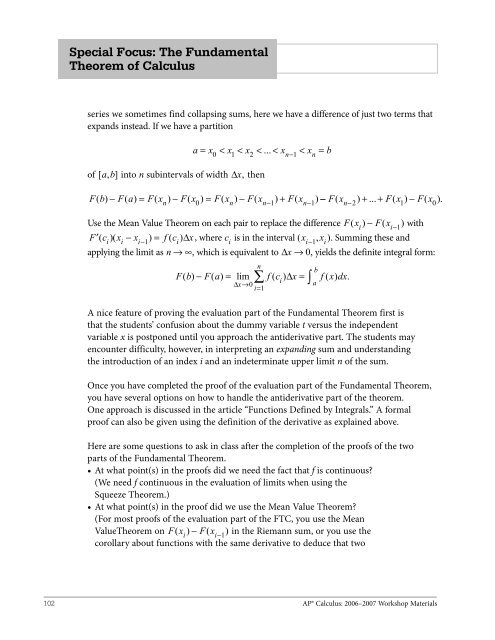AP Calculus
Create successful ePaper yourself
Turn your PDF publications into a flip-book with our unique Google optimized e-Paper software.
Special Focus: The Fundamental<br />
Theorem of <strong>Calculus</strong><br />
series we sometimes find collapsing sums, here we have a difference of just two terms that<br />
expands instead. If we have a partition<br />
a = x < x < x < ... < x < x = b<br />
0 1 2 n−1<br />
of [ a, b ] into n subintervals of width ∆x, then<br />
F ( b ) − F ( a ) = F ( xn ) − F ( x0 ) = F ( xn ) − F ( xn−1 ) + F ( xn−<br />
1 ) − F( xn−2) + ... + F( x1) − F( x0<br />
).<br />
Use the Mean Value Theorem on each pair to replace the difference F ( xi<br />
) − F ( xi−1 ) with<br />
F′ ( ci )( xi − xi−<br />
1) = f ( ci<br />
) ∆ x , where c i<br />
is in the interval ( x i−1<br />
, xi)<br />
. Summing these and<br />
applying the limit as n → ∞, which is equivalent to ∆x → 0, yields the definite integral form:<br />
n<br />
b<br />
∑ i ∫<br />
∆x→ 0<br />
a<br />
i = 1<br />
F( b) − F( a) = lim f ( c ) ∆x = f ( x) dx.<br />
A nice feature of proving the evaluation part of the Fundamental Theorem first is<br />
that the students’ confusion about the dummy variable t versus the independent<br />
variable x is postponed until you approach the antiderivative part. The students may<br />
encounter difficulty, however, in interpreting an expanding sum and understanding<br />
the introduction of an index i and an indeterminate upper limit n of the sum.<br />
Once you have completed the proof of the evaluation part of the Fundamental Theorem,<br />
you have several options on how to handle the antiderivative part of the theorem.<br />
One approach is discussed in the article “Functions Defined by Integrals.” A formal<br />
proof can also be given using the definition of the derivative as explained above.<br />
Here are some questions to ask in class after the completion of the proofs of the two<br />
parts of the Fundamental Theorem.<br />
• At what point(s) in the proofs did we need the fact that f is continuous?<br />
(We need f continuous in the evaluation of limits when using the<br />
Squeeze Theorem.)<br />
• At what point(s) in the proof did we use the Mean Value Theorem?<br />
(For most proofs of the evaluation part of the FTC, you use the Mean<br />
ValueTheorem on F ( xi<br />
) − F ( xi−1 ) in the Riemann sum, or you use the<br />
corollary about functions with the same derivative to deduce that two<br />
n<br />
102<br />
<strong>AP</strong>® <strong>Calculus</strong>: 2006–2007 Workshop Materials


